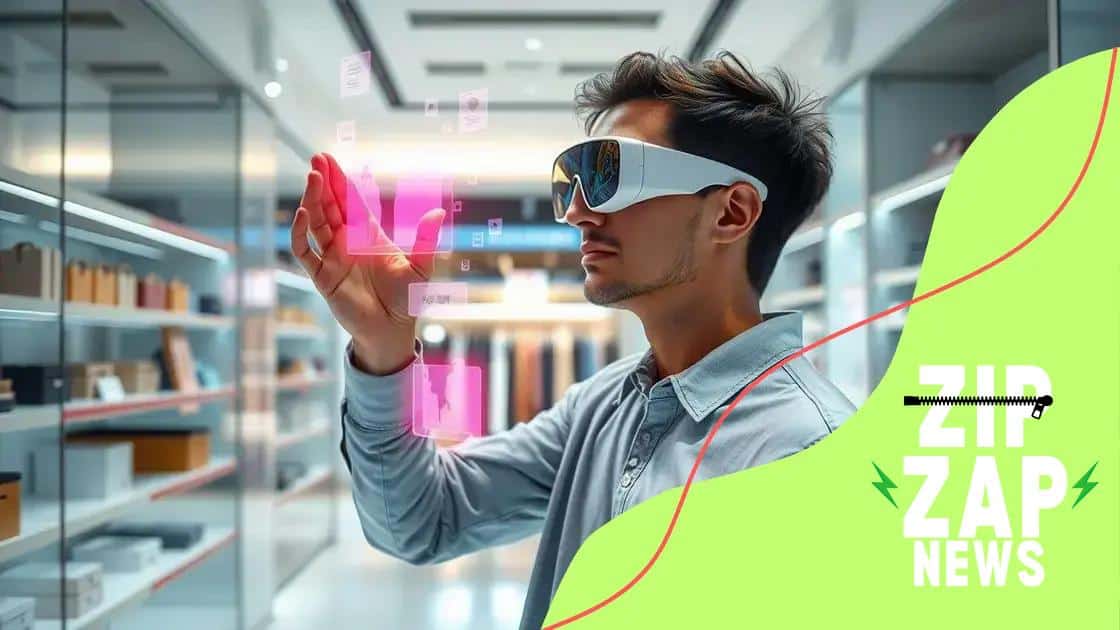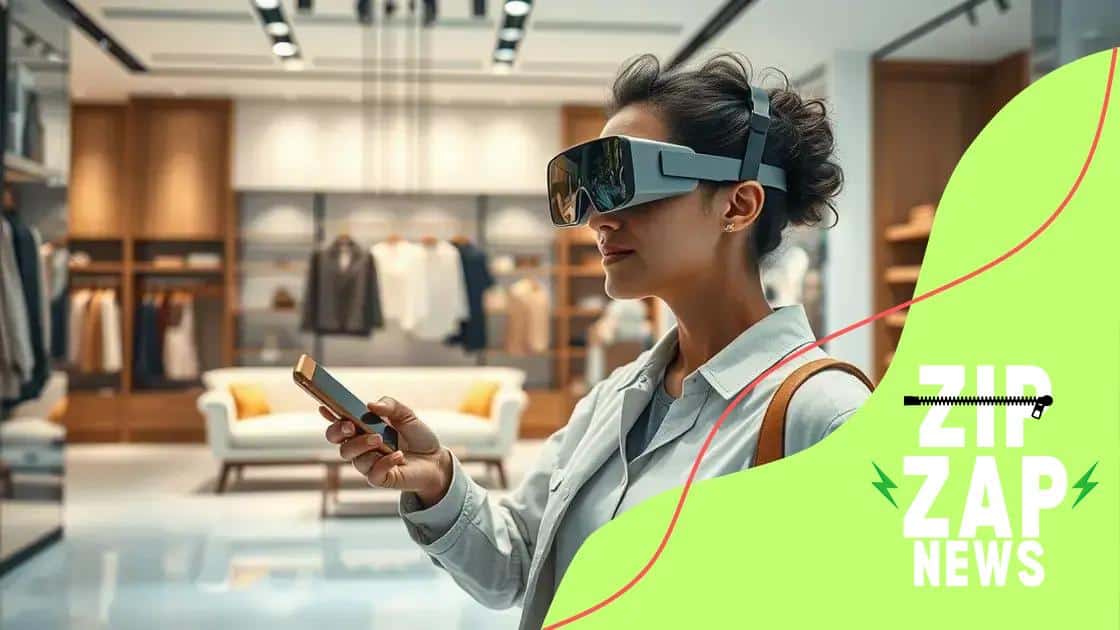Augmented reality in e-commerce experiences: a game changer

Augmented reality in e-commerce significantly enhances customer engagement and product visualization, providing immersive shopping experiences that boost sales while also facing challenges like implementation costs and technology limitations.
Augmented reality in e-commerce experiences is changing the way we shop online. Imagine trying on clothes virtually or visualizing furniture in your living room before buying! This technology offers exciting possibilities that can enhance your shopping experience.
Understanding augmented reality in e-commerce
Understanding augmented reality in e-commerce is crucial for businesses looking to enhance the online shopping experience. This technology bridges the gap between the physical and digital worlds, allowing customers to interact with products in innovative ways.
By integrating augmented reality, retailers can offer immersive shopping experiences where shoppers can visualize products in their real environment. Imagine being able to place a virtual sofa in your living room to see how it fits before making a purchase.
Benefits of Augmented Reality
There are numerous benefits to incorporating AR into e-commerce. For instance:
- Improved customer engagement through interactive experiences.
- Reduction in return rates as customers can better evaluate products.
- Enhanced brand loyalty by creating memorable shopping experiences.
Additionally, augmented reality can help customers make more informed decisions. For example, trying on clothes virtually allows them to see how different styles and sizes fit their bodies without needing to enter a fitting room.
How AR Works in E-commerce
Augmented reality in e-commerce typically utilizes mobile devices or AR glasses to overlay digital information onto the physical world. Shoppers can scan items in a store or visualize a product through their smartphone screens. This technology creates a seamless interaction between the consumer and the product, increasing confidence in their purchase.
Notably, many major retailers are adopting augmented reality technology to reach tech-savvy consumers. By enhancing the shopping experience, companies not only boost sales but also help build an innovative brand image.
How AR improves product visualization
How AR improves product visualization is a key factor in enhancing customer experience in e-commerce. With augmented reality, shoppers can see products in a 3D format, helping them understand dimensions and designs better.
This technology brings a new level of interaction, allowing customers to visualize how a product fits into their lives. For instance, when purchasing furniture, customers can view how a couch looks in their own living room. This capability reduces uncertainty and increases confidence in buying.
Benefits of AR for Product Visualization
Using augmented reality in product visualization presents several benefits:
- Offers realistic views of products in various settings.
- Enhances understanding of product features and scale.
- Increases customer engagement by creating interactive experiences.
Additionally, AR can showcase products from multiple angles, allowing customers to inspect every detail. This feature caters to the modern consumer’s desire for transparency and assurance.
Examples of AR in Action
Many e-commerce brands leverage AR technology to enhance product visualization. For example, cosmetic companies allow users to see how different makeup products look on their skin via virtual try-ons. Similarly, clothing retailers provide digital fitting rooms where users can see how clothes fit their body shape.
This technology does not only serve a practical purpose, it also adds a fun element to online shopping. As consumers interact with products in a virtual environment, they are likely to spend more time browsing, leading to increased sales.
The impact of AR on customer engagement

The impact of AR on customer engagement is profound and transformative for e-commerce. With augmented reality, businesses can create highly interactive experiences that draw customers in and encourage deeper interactions with products.
By using AR technology, brands can elevate their marketing strategies and offer unique experiences. For example, customers can use their smartphones to visualize products in their real-world environments. This not only captivates their attention but also fosters a connection between the customer and the brand.
Enhanced Interaction
One major benefit of AR is the way it enhances interaction between consumers and products. Customers can:
- Try on items virtually without physical limitations.
- Visualize how products fit in their everyday spaces.
- Engage with brands through immersive promotional campaigns.
This significant enhancement in interaction leads to increased time spent on websites and higher rates of conversion. When shoppers feel engaged, they are more likely to complete a purchase.
Building Brand Loyalty
Augmented reality not only boosts engagement but also builds brand loyalty. When customers have fun and memorable experiences with a brand, they are more likely to return. For instance, brands that create AR experiences often see positive word-of-mouth as satisfied customers share their experiences on social media.
This type of engagement also helps brands understand customer preferences through interaction data. Companies can tailor their offers based on how customers engage with their AR features, leading to more effective marketing strategies and personalized experiences.
Challenges of implementing AR in e-commerce
Implementing AR in e-commerce comes with several challenges that businesses must navigate. Despite its benefits, companies face hurdles that can affect the effectiveness of AR solutions in their marketing strategies.
One major challenge is the cost associated with developing high-quality AR experiences. Creating immersive and interactive features requires significant investment in technology and skilled personnel. This can be a barrier for smaller businesses that may not have the budget to allocate for such advancements.
Technical Limitations
Technical limitations are also a concern when integrating augmented reality. The quality of the AR experience is highly reliant on devices and software capabilities. For instance, older smartphones may not support advanced AR features, causing issues for users trying to access these functions.
- Compatibility issues with different operating systems.
- Inconsistent performance across various devices.
- Fragmentation of user experiences due to device limitations.
Moreover, maintaining the AR technology to ensure smooth operation can also demand extra resources, which could strain smaller enterprises.
User Acceptance
User acceptance plays a critical role in the successful implementation of AR. Some customers may be unfamiliar or skeptical about using AR to shop. Educating customers on how to use these features effectively can require additional effort from businesses.
Businesses need to consider how to promote AR features and explain their usefulness to build trust and encourage usage. This may involve tutorials, demonstrations, or interactive marketing campaigns designed to familiarize customers with the technology. Without proper guidance, customers may struggle to see the value of augmented reality.
Future trends of AR in online shopping
Future trends of AR in online shopping are exciting and indicate substantial growth in how customers will interact with brands. As technology advances, we expect augmented reality to become a standard part of the shopping experience.
One major trend is the increased personalization of AR experiences. Brands will use data analytics to tailor AR features to individual preferences, allowing for a more customized shopping journey. Customers will be able to see products that match their style or needs in real-time, enhancing their overall satisfaction.
Integration with Social Media
Another trend is the integration of augmented reality with social media platforms. As these platforms evolve, they are becoming more interactive and will likely incorporate AR features directly into their shopping interfaces. Shoppers may be able to try products in a virtual environment while socializing online, thus merging social experiences with e-commerce.
- Interactive AR ads that allow users to try products instantly.
- Sharing AR experiences on social media for better engagement.
- Influencers using AR to promote products directly in their content.
This integration will not only enhance user experience but will also drive traffic to e-commerce sites, creating new opportunities for brands to connect with consumers.
Advancements in Technology
Technological advancements will play a critical role in the future of AR in online shopping. Improved hardware, such as AR glasses and smartphones with better capabilities, will allow for more sophisticated applications and smoother experiences. Additionally, artificial intelligence will help refine the AR shopping experience by learning user preferences and behaviors to optimize recommendations.
As AR technology becomes more accessible, smaller brands will also have opportunities to participate, leveling the playing field in online shopping. This democratization of access will spur innovation and creativity, resulting in unique AR experiences across various industries.
In conclusion, augmented reality (AR) is changing the landscape of e-commerce. It enhances customer engagement, improves product visualization, and creates unique shopping experiences. While there are challenges, such as costs and technical limitations, the future of AR in online shopping looks bright. As technology advances, we can expect even more personalized and immersive experiences that will transform the way we shop. Companies willing to adopt and innovate with AR will likely see significant benefits as they connect with consumers in new and exciting ways.
\n
\n
FAQ – Frequently Asked Questions about Augmented Reality in E-commerce
How does augmented reality enhance the shopping experience?
Augmented reality allows customers to visualize products in real-life settings, making it easier to decide on purchases.
What are the main challenges of implementing AR in e-commerce?
The main challenges include high development costs, technical limitations of devices, and ensuring user acceptance.
Will AR become a standard part of online shopping?
Yes, as technology advances and becomes more accessible, AR is likely to become a standard feature in e-commerce.
How can businesses benefit from adopting AR technology?
Businesses can improve customer engagement, personalize shopping experiences, and ultimately boost sales by adopting AR technology.





